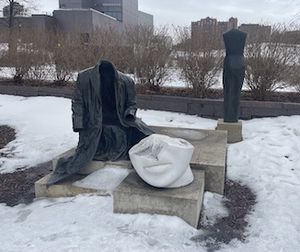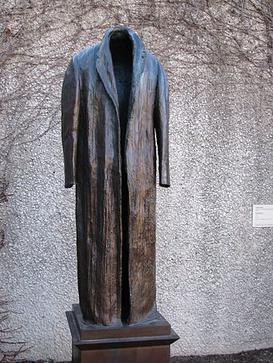Judith Shea facts for kids
Quick facts for kids
Judith Shea
|
|
|---|---|

Judith Shea, Without Words (1988), Minneapolis Sculpture Garden
|
|
| Born | 1948 Philadelphia, Pennsylvania, United States
|
| Alma mater | Parsons School of Design |
| Known for | Fashion design |
| Patron(s) | 16 |
Judith Shea is an American artist who creates sculptures. She was born in Philadelphia, Pennsylvania, in 1948. Judith studied fashion design and fine arts at the Parsons School of Design. This special education helped her create art that often features human figures and clothing.
Her art career has had three main stages. First, from 1974 to 1981, she used cloth and clothing shapes. Then, from 1982 to 1991, she made hollow metal sculptures of clothing and figures. Since 1990, she has been carving full-figure statues from materials like wood, cloth, clay, foam, and even hair.
Contents
About Judith Shea's Art
Judith Shea first showed her art in New York City in 1976. She created a performance using sheer silk shirts and pants in many colors. A dancer changed clothes, mixing new colors as layers were added or removed. This show traveled to museums and art festivals across the country.
In 1981, she displayed simple forms that looked like clothes from her childhood. These included a black overcoat and two simple dresses. To Judith, these clothing shapes helped show that a human presence was there, even without a person.
Creating Metal Sculptures
With help from grants in 1984 and 1986, Judith began making her figures from iron and bronze. This allowed her to create more three-dimensional sculptures. In 1986, she also went to Paris to study the statues in parks and gardens.
This research led to several hollow-figure sculptures designed for public places. Some of these works include Eden (1986), Shepherd’s Muse (1988), and Without Words (1988). Another famous piece is "Post-Balzac" (1990), which is at the Hirshhorn Museum and Sculpture Garden.
Carving Ironic Monuments
In 1987, Judith Shea was an artist-in-residence in Kutztown, Pennsylvania. Later, in 1989, she worked at Chesterwood, which was the summer studio of sculptor Daniel Chester French. He was famous for his Lincoln Memorial monument.
Inspired by this, Judith began carving what she called "ironic monuments" from wood. In 1993, she had a show called "All About Adam, and Eve." One important sculpture was "No More Monument." It showed a large, middle-aged man on a small, tired farm horse. This artwork questioned who we celebrate as heroes in our monuments.

In 1994, Judith created The Other Monument. This wooden sculpture showed a free Black man riding a black horse. It was placed in New York City, near a monument of General William Tecumseh Sherman from the Civil War. Judith had studied Civil War art and realized there were no monuments celebrating the end of slavery. Her sculpture was her way of adding this missing monument.
Legacy Collection and Later Works
After traveling and receiving fellowships in Italy and Mexico, Judith Shea started a new series of works around 2000. These pieces explored figures as characters and symbols. This led to her major project called Judith Shea: Legacy Collection.
This collection was inspired by her personal experience of the 9/11 events. She lived very close to the World Trade Center site. She created mannequin-like figures, covered in dust, looking up as if from a store window. These sculptures showed the contrast between success and the disaster. Some works from this series are now at the Yale University Art Gallery.
In 2012, Judith curated an exhibition at The National Academy Museum. She chose portraits and self-portraits by female artists from their collection. In a video about the exhibit, she talked about how each woman showed herself and what was important to her as an artist. Judith also made new sculptures for the show, honoring three of her favorite sculptors.
Awards and Recognition
Judith Shea has received many important awards for her sculptures. These awards recognize her talent and contributions to the art world.
- 2013: ARTS AND LETTERS AWARD IN ART from the American Academy of Arts and Letters.
- 2013: AWARD FOR EXCELLENCE from The National Academy Museum.
- 2012: GUGGENHEIM FELLOW in Fine Arts.
- 2011: ANONYMOUS WAS A WOMAN AWARD.
- 2011: ARTISTS’ LEGACY FOUNDATION ARTIST AWARD.
- 2007: CHARLOTTE DUNWIDDIE PRIZE for SCULPTURE.
- 1995: ARTS INTERNATIONAL-LILA WALLACE READER’S DIGEST: International Artist Award.
- 1994: ROME PRIZE FELLOWSHIP from the American Academy in Rome.
- 1993: FELLOW of the AUGUSTUS SAINT-GAUDENS MEMORIAL.
- 1993: ROCKEFELLER FOUNDATION RESIDENT FELLOWSHIP.
- 1989: The GUGGENHEIM MUSEUM SCULPTOR in RESIDENCE at CHESTERWOOD.
- 1986: NATIONAL ENDOWMENT for the ARTS: Individual Artist Fellowship.
- 1984: NATIONAL ENDOWMENT for the ARTS: Individual Artist Fellowship.
Where to See Her Art
Judith Shea's artwork is displayed in many public art collections across the United States. This means you can see her sculptures in museums and galleries.
- Yale University Art Gallery
- Hirshhorn Museum and Sculpture Garden in Washington, D.C.
- Museum of Modern Art in New York City
- Nelson-Atkins Museum of Art in Kansas City
- Whitney Museum of American Art in New York
- Walker Art Center in Minneapolis, Minnesota
- NATIONAL GALLERY in Washington, D.C. (Herbert & Dorothy Vogel Collection)
- MCASD in San Diego, CA
- Santa Barbara Museum of Art in Santa Barbara, CA
- Sheldon Memorial Art Gallery University of Nebraska in Lincoln, NE
- Weatherspoon Art Museum UNC Greensboro in Greensboro, NC
- Addison Gallery Phillips Academy in Andover, MA
- Albright-Knox Gallery in Buffalo, NY
- Brooklyn Museum in Brooklyn, NY
- Des Moines Art Center in Des Moines, IA (John and Mary Pappajohn Sculpture Park)
- Laumeier Sculpture Park in St. Louis, MO

